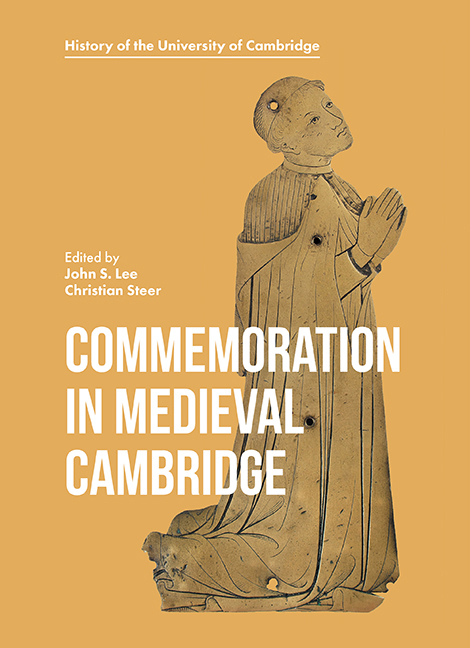Book contents
- Frontmatter
- Contents
- List of Illustrations
- Acknowledgements
- List of Contributors
- Abbreviations
- Introduction: In Fellowship with the Dead
- 1 Monuments and Memory: A University Town in Late Medieval England
- 2 The Commemoration of the Living and the Dead at the Friars Minor of Cambridge
- 3 The City of London and the Founding of the Guild of Corpus Christi
- 4 Patrons and Benefactors: The Masters of Trinity Hall in the Later Middle Ages
- 5 A Comparison of Academical and Legal Costume on Memorial Brasses
- 6 Commemoration at a Royal College
- 7 Cambridge Commemorations of Lady Margaret Beaufort's Household
- 8 ‘The Stones are all disrobed’: Reasons for the Presence and Absence of Monumental Brasses in Cambridge
- Bibliography
- Index
2 - The Commemoration of the Living and the Dead at the Friars Minor of Cambridge
Published online by Cambridge University Press: 25 October 2019
- Frontmatter
- Contents
- List of Illustrations
- Acknowledgements
- List of Contributors
- Abbreviations
- Introduction: In Fellowship with the Dead
- 1 Monuments and Memory: A University Town in Late Medieval England
- 2 The Commemoration of the Living and the Dead at the Friars Minor of Cambridge
- 3 The City of London and the Founding of the Guild of Corpus Christi
- 4 Patrons and Benefactors: The Masters of Trinity Hall in the Later Middle Ages
- 5 A Comparison of Academical and Legal Costume on Memorial Brasses
- 6 Commemoration at a Royal College
- 7 Cambridge Commemorations of Lady Margaret Beaufort's Household
- 8 ‘The Stones are all disrobed’: Reasons for the Presence and Absence of Monumental Brasses in Cambridge
- Bibliography
- Index
Summary
In imitation of the apostolic community, the monastic world was centred on the celebration of the Divine Office and a life of self-abnegation within the cloister, where the individual lived, worked and prayed; one dimension of the monks’ interaction with society was their intercession for founders, patrons and benefactors. By the later twelfth century a fresh understanding of the vita apostolica was gaining ground in western Europe, a concept that inspired St. Francis of Assisi to testify to the Gospel by engaging with society in a global cloister; his calling was to take Christian principles to the market place, the streets and the cross-roads. His followers divested themselves of their possessions and engaged in manual work in the towns and cities where they dwelt. This novel model of religious life was transplanted to England by nine penniless friars who landed in Kent during the late summer of 1224. Within a few years they were winning plaudits, initially for their testimony to the Gospel and then for their preaching, a ministry that became emblematic of their contribution to the local Church. Another conspicuous contribution lay in the realm of suffrages: a premium was placed on their intercession and members of the laity, the clergy and fellow religious eagerly sought their prayers. This study explores the order's establishment in Cambridge, the church of the Friars Minor in the town, the friars and intercession, the legion of testators and those interred in their church.
THE FRIARS’ SETTLEMENT IN CAMBRIDGE
The Roman town of Cambridge had much to commend it to the friars through its ancient market close to the parish church of St. Mary, its network of a dozen or so parish churches in the thirteenth century, the hospital of St. John the Evangelist and the nunnery of St. Radegund. In addition, the growth of the schools of Cambridge into a university that offered a degree in theology was a further attraction for the friars, who were already drawing students from Oxford University to their ranks. The friars were first welcomed to Cambridge by the burgesses about 1225 and they were initially accommodated on the site of the present Guildhall.
- Type
- Chapter
- Information
- Commemoration in Medieval Cambridge , pp. 34 - 51Publisher: Boydell & BrewerPrint publication year: 2018

